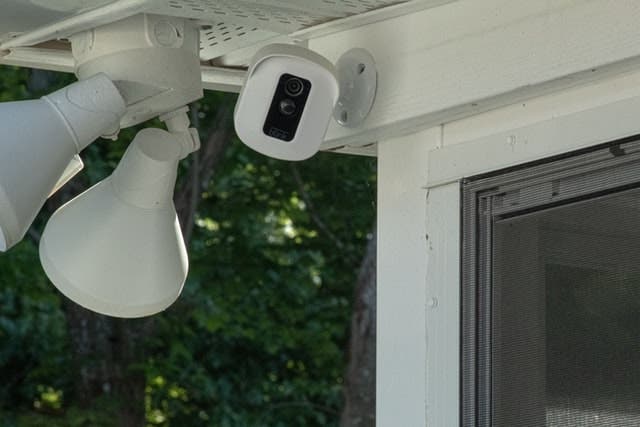Installing a home security camera is one of the smartest steps you can take to protect your home and belongings. Installing a surveillance system to watch over your property will give you peace of mind when you’re not around. Smart home devices may even create a benefit on your homeowners insurance.
You could hire someone to do a professional installation, but handling the setup yourself is a moderately easy DIY job if you’re comfortable following instructions and using a few basic tools. All you really need is a drill, a screwdriver, and a ladder to complete your own security camera installation.
Map Out Your Setup

Before you purchase a security camera system for your home, it’s vital to create an installation plan. Doing some planning first will help you buy your system, since you’ll know how many cameras you need. You don’t want extra cameras in a box, and your home security system won’t be very useful if it has blind spots.
Identify Key Locations
Start by drawing a map of your home. Designate the key locations that you want to monitor, such as your front door, back door, windows, driveway, garage, and any other space that may be vulnerable.
Plan Optimal Coverage
Use the map to plan the camera positions for optimal coverage and minimal blind spots. The plan should also include a secure location for your recording device. And don’t forget to account for the wiring for power and ethernet cables.
Select Your Home Security Cameras
The security system you choose will depend on your needs and budget.
Wired Security Cameras
If you have a large home, a wired security camera solution may be the most reliable option. Wired cameras often offer higher resolution recording than their wireless counterparts. The downside is that you’ll need to drill holes and run cables to install a wired camera system.
Wireless Security Cameras
A wireless home security solution is a good choice for smaller homes or apartments where you can’t drill holes in the wall for cables. You’ll need a strong Wi-Fi connection for the cameras to function properly. Some wireless security cameras run on batteries while some have to stay plugged into a power outlet.
Security Camera Features
Almost all security cameras include motion detection to trigger your digital video recorder (DVR) to record footage. Some cameras also support night vision so you can capture movement even in the dark. Outdoor security cameras are designed to withstand rain and snow. Don’t forget to check the approved operating temperature if you live in an area with extreme cold or heat.
Mount the Cameras

Once you map out your locations and purchase your cameras, it’s time to start mounting them to the wall. Before drilling holes, verify that the sites you chose for camera placement provide adequate visual coverage. Don’t forget to account for each camera’s maximum field of view.
If you’re using battery-powered cameras, all you need to do is mount the cameras to your ceiling or walls. Most DIY security cameras include a drill template to simplify the installation process. Follow the template to drill the holes exactly where you need them. If you don’t have a drill template, hold the camera where you want to mount it and trace the holes with a pencil before drilling.
Don’t Forget the Power Source
Wired security camera DIY installations require a little bit more work. You’ll need to drill a larger hole for the power and data cables. Some wired security cameras get power through their network connection via a Power of Ethernet (PoE) network switch, but most require a power outlet to function.
Thankfully, most cameras come with their own extension cables, so you won’t need to hire an electrician to run power close to your cameras.
Security System Video Storage

Once your cameras are in place, the last thing to do is connect them to a storage solution. Some wireless cameras use SD cards to store video locally, but most sync to a cloud storage solution to save your security camera videos online. This also allows for remote viewing from your smartphone through your system’s app.
Hardwired security systems connect to a DVR, which captures the footage from as many as 16 cameras at once. It’s easy to access the recordings stored on a DVR for review.






